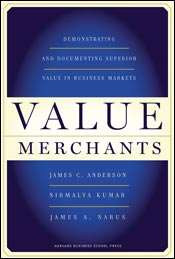A conversation with...James A. Narus
Professor of Business Marketing at the Babcock Graduate School of Management, Wake Forest University
In the finishing business, as in any sector of manufacturing, pressure to compete on the basis of price is a constant threat to profit margins. Many finishers feel their products and services have greater value than those of their competitors, yet still find themselves matching prices to make the sale. James A. Narus, Professor of Business Marketing at the Babcock Graduate School of Management, Wake Forest University (Charlotte, NC), has co-written a new book that teaches business owners how to market and sell products and services based on value rather than price. We spoke with Narus about the book, Value Merchants, and what it can mean to finishers seeking to improve profit margins in a tough economy.
What led you to write Value Merchants?
A lot of business owners express frustration with their sales people because when they get into the thick of intense negotiation, they tend to cave on price. That ruins your margins and your profitability. Even more frustrating is when the sales person gives away for free something that you’re doing. We wanted to take a look at what causes people to compete on price and come up with recommendations to get them to sell value instead of price.
Featured Content
In the book you talk about customer value management. Can you explain what that is?
It’s a structured approach that begins with a rigorous assessment of what brings value to the customer—the benefits that he [the customer] is willing to pay for—in contrast with guessing and giving away things for free. Understand what the customer values and then craft your sales approach around that.
There are two important ideas. You want to eliminate value drains—services that cost you more to provide then they’re worth to your customer. You can be bending over backward, incurring costs for something that doesn’t increase your customer’s willingness to pay. And then you want to identify value leaks—things your customer is doing that add costs that they’re not aware of.
How do you find out what these are? It’s not exactly a question you can just ask.
In finishing, you’re selling the service and knowledge as well as the physical product. Get your operations people into the field and dealing with the customer, not just your sales people. You can conduct joint sales calls so that the sales person accompanies a technical person. This gets you away from the customers’ purchasing people and talking to the operations people, who are actually going to be using your products. The discussion then moves away from price and onto the technology.
Another approach that many companies use is co-location. Have your person spend time working shoulder-to-shoulder with your customer, so they have a better feel for the company’s process and can make suggestions for improvements. A third thing many finishers can do is sell augmenting services such as repair or maintenance. These can be opportunities to get into the customer’s plant, see their processes, and build trust and recognition.
How can our readers incentivize their salespeople to become value merchants?
In chapter seven of the book, we talk about how to convert sales people from those that give away low prices to those that sell value. One idea is to hold a margin builder contest. The basic idea is to shift bonuses and commission off of units and dollars sold to gross margin or contribution margin. There are many examples of companies that have done that successfully.




















